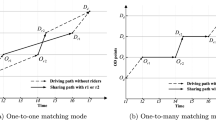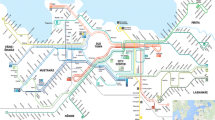Abstract
In travel behavior modeling, an important topic is to investigate what drives people to travel. A systematic analysis should examine why, where and when various activities are engaged in, and how activity engagement is related to the spatial and institutional organization of an urban area. In view of this, this paper presents a stochastic model for solving the combined activity/destination/route choice problem. It is a time-dependent model for long-term transport planning such as travel demand forecasting. The activity/destination choices are based on multinomial logit formulae and, the route choice is governed by stochastic user equilibrium principle. The solution algorithm is proposed together with a numerical example for demonstration. It is shown that the proposed modeling approach provides a powerful tool for fully understanding and predicting the complex travel behavior at strategic level.
Similar content being viewed by others
References
Axhausen, K.W. (1990). “A Simultaneous Simulation of Activity Chains and Traffic Flow.” In P. Jones (ed.), Development in Dynamic and Activity-Based Approaches to Travel Analysis. Avebury, Aldershot, England, pp. 206–225.
Axhausen, K.W. and T. Garling. (1992). “Activity-based Approaches to Travel Analysis: Conceptual Frameworks, Models and Research Problem.” Transport Review 12, 323–341.
Ben-Akiva, M. and S.R. Lerman. (1985). Discrete Choice Analysis, Theory and Application to Travel Demand. The MIT Press.
Damm, D. (1982). “Parameters of Activity Behavior for Use in Travel Analysis.” Transportation Research-A 16, 135–148.
Damm, D. (1983). “Theory and Empirical Results: A Comparison of Recent Activity-Based Research.” In S. Carpenter and P. Jones (eds.), Recent Advances in Travel Demand Analysis. Gower, Aldershot, England, pp. 3–33.
Fellendorf, M., T. Haupt, U. Heidi, and W. Scherr. (1995). “PTV VISION: Activity Based Demand Forecasting in Daily Practices.” Presented at The Travel Model Improvement Program Conference. Daytona Beach, Florida.
Goodwin, P.B. (1983). “Some Problems in Activity Approaches to Travel Demand.” In S. Carpenter and P. Jones (eds.), Recent Advances in Travel Demand Analysis. Gower, Aldershot, England, pp. 470–474.
Huang, H.-J. (1995). “A Combined Algorithm for Solving and Calibrating the Stochastic User Equilibrium Assignment Model.” Journal of the Operational Research Society 46, 977–987.
Huang, H.-J. and M.G.H. Bell. (1998). “A Study on Logit Assignment Which Excludes all Cyclic Flows.” Transportation Research-B 32, 401–412.
Jones, P.M., F.S. Koppelman, and J.P. Orfueil, (1990). “Activity Analysis: State-of-the-Art and Future Directions.” In P.M. Jones (ed.), New Developments in Dynamic and Activity-Based Approaches to Travel Analysis. Gower Publishing: Aldershot, England, pp. 34–55.
Kitamura, R., E.I. Pas, C.V. Lula, T.K. Lawton, and P.E. Benson. (1996). “The Sequenced Activity Mobility Simulator (SAMS): An Integrated Approach to Modeling Transportation, Land Use and Air Quality.” Transportation 23, 267–291.
Kitamura, R. and J. Supernak. (1997). “Temporal Utility Profiles of Activities and Travel: Some Empirical Evidence.” In P. Stopher and M. Lee-Gosselin (eds.), Understanding Travel Behavior in an Era of Change. Elsevier Science Ltd., pp. 339–350.
Kondo, K. and R. Kitamura. (1987). “Time-Space Constraints and the Formation of Trip Chains.” Regional Science and Urban Economics 17, 49–65.
Lam, W.H.K and H.-J. Huang. (2002). “A Combined Activity/Travel Choice Model for Congested Road Networks with Queues.” Transportation 29, 5–29.
Lam, W.H.K. and Y. Yin. (2001). “An Activity-Based Time Dependent Traffic Assignment Model.” Transportation Research-B 35, 549–574.
Nishii, K., K. Kondo, and R. Kitamura. (1990). “Empirical Analysis of Trip Chaining Behavior.” Transportation Research Record 1203, 48–59.
Oster C.V. (1979). “The Second Role of the Work Trip: Visiting Non-work Destination.” Transportation Research Record 728, 79–81.
Sheffi, Y. (1985). Urban Transportation Networks: Equilibrium Analysis with Mathematical Programming Methods. Prentice-Hall, Englewood Cliffs, New Jersey.
Supernak, J. (1990). “A Dynamic Interplay of Activities and Travel: Analysis of Time of Day Utility Profiles.” In P. Jones (ed.), Development in Dynamic and Activity-Based Approaches to Travel Analysis, Avebury, Aldershot, England, pp. 206–225.
Author information
Authors and Affiliations
Corresponding author
Additional information
The work described in this paper was substantially supported by the grants from the National Natural Science Foundation of China (Project No. 79825101), the Chinese Academy of Sciences (MADIS Research Project) and the Research Grants Council of the Hong Kong Special Administrative Region (Project No. PolyU5077/97E).
Rights and permissions
About this article
Cite this article
Huang, HJ., Lam, W.H.K. A Stochastic Model for Combined Activity/Destination/Route Choice Problems. Ann Oper Res 135, 111–125 (2005). https://doi.org/10.1007/s10479-005-6237-5
Issue Date:
DOI: https://doi.org/10.1007/s10479-005-6237-5




